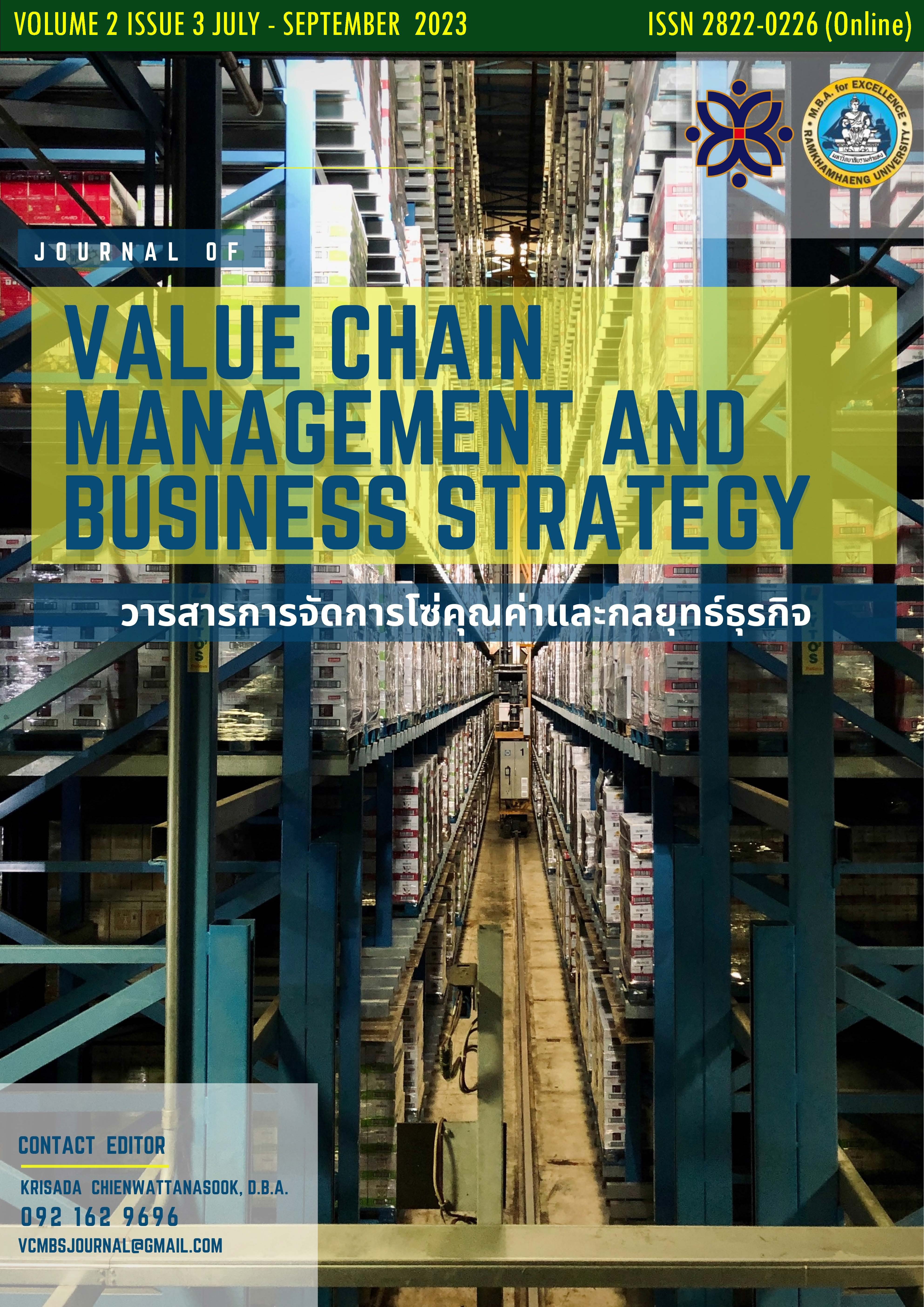THE RELATIONSHIPS BETWEEN WORK-LIFE QUALITY AND EMPLOYEE PERFORMANCE: A CASE OF HUAZHI EXCELLENT PRODUCTIVITY PROMOTION (BEIJING) CO., LTD.
คำสำคัญ:
Work-Life Quality, Employee Performanceบทคัดย่อ
Businesses may struggle when management fails to see the relationship between work-life balance and worker productivity. Poorer productivity, employee stress and attrition, and higher recruitment and training costs are a few of these. The ability of businesses to implement successful policies and practices enhancing work-life quality, organizational performance, and talent attraction and retention may be hampered by a lack of understanding regarding this connection. Issues with the quality of work-life for employees can harm their physical and mental health, which has a negative impact on productivity and absenteeism. The purpose of this study was to investigate the relationship between work-life quality and employee performance in Huazhi Excellent Productivity Promotion (Beijing) Co. The sample used in the study consisted of 82 employees in Huazhi Excellent Productivity Promotion (Beijing) Co, Ltd. A set of questionnaires were used as the instrument for data collection. The content validity value of the questions is 1.00 and the reliability coefficient of the questionnaire is 0.819. The following statistics were used in data analysis: Frequency, percentage, mean, standard deviation, and multiple regression analysis.
The result found that work-life quality including working conditions (β = 0.216), the opportunity for advancement (β = 0.200), the opportunity to develop one's abilities (β = 0.383), and sufficient and fair compensation (β = 0.229) affecting employee's performance. Statistically significant at the level of 0.05, all four variables together predict employee performance up to 86.2%.
เอกสารอ้างอิง
Afroz, S. (2017). Quality of work life: A conceptual model. Advances in Economics and Business Management (AEBM), 4(8), 570-578.
Ajala, E. M. (2013). Quality of work life and workers wellbeing: The industrial social workers approach. IFE Psychologia: An International Journal, 21(2), 46-56.
Arifani, A. Z. T., & Susanti, A. Y. (2020). Literature Review Factors Affecting Employee Performance: Competence, Compensation, And Leadership. Dinasti International Journal of Economics, Finance & Accounting, 1(3), 538-549.
Bassey, B. E., & Tapang, A. T. (2012). Capitalized human resources cost and its influence on corporate productivity: A study of selected companies in Nigeria. International Journal of Financial Research, 3(2), 48-59.
Bessen, J. (2019). Automation and jobs: When technology boosts employment. Economic Policy, 34(100), 589-626.
Bhende, P., Mekoth, N., Ingalhalli, V., & Reddy, Y. V. (2020). Quality of work-life andwork–life balance. Journal of Human Values, 26(3), 256-265.
Bhola, D. J., & Nigade, J. (2016). Relationship between work-life balance, quality of work life and quality of life of women working in service industry. Research Gate, 15(1), 30-45.
Candradewi, I., & Dewi, I. G. A. M. (2019). Effect of compensation on employee performance towards motivation as mediation variable. International research journal of management, IT and social sciences, 6(5), 134-143.
Chrisman, J. J., Devaraj, S., & Patel, P. C. (2017). The impact of incentive compensation on labor productivity in family and nonfamily firms. Family Business Review, 30(2), 119-136.
Dakhoul, Z. M. (2018). The determinants of employee performance in Jordanian organizations. Journal of Economics Finance and Accounting, 5(1), 137-143.
Gadhavi, D., Parikh, A., Patel, V., Joshi, N., & Thaker, D. (2021). Employee wellbeing and employee's happiness: A study of an Indian University. Academy of Strategic Management Journal, 20, 1-11.
Guan, X., & Frenkel, S. (2019). How perceptions of training impact employee performance: Evidence from two Chinese manufacturing firms. Personnel review, 48(1), 163-183.
Khan, S., & Abdullah, N. N. (2019). The impact of staff training and development on teachers’ productivity. Economics, Management and Sustainability, 4(1), 37-45.
Kundi, Y. M., Aboramadan, M., Elhamalawi, E. M., & Shahid, S. (2021). Employee psychological well-being and job performance: exploring mediating and moderating mechanisms. International Journal of Organizational Analysis, 29(3), 736-754.
Leitão, J., Pereira, D., & Gonçalves, Â. (2019). Quality of work life and organizational performance: Workers’ feelings of contributing, or not, to the organization’s productivity. International journal of environmental research and public health, 16(20), 3803.
Nasim, K. (2018). Role of internal and external organizational factors in TQM implementation: A systematic literature review and theoretical framework. International Journal of Quality & Reliability Management, 35(5), 1014-1033.
Ogbonnaya, C., & Messersmith, J. (2019). Employee performance, well‐being, and differential effects of human resource management subdimensions: Mutual gains or conflicting outcomes?. Human Resource Management Journal, 29(3), 509-526.
Osborne, S., & Hammoud, M. S. (2017). Effective employee engagement in the workplace. International Journal of Applied Management and Technology, 16(1), 4.
Peterson, E. & Plowman, E. G. (1953). Business Organization and Management. Homewood, Ill.: Richard D. Irwin.
Pradhan, R. K., & Jena, L. K. (2017). Employee performance at workplace: Conceptual model and empirical validation. Business Perspectives and Research, 5(1), 69-85.
Shobe, K. (2018). Productivity driven by job satisfaction, physical work environment, management support and job autonomy. Business and Economics Journal, 9(2), 1-9.
Shrestha, A. K., & Chhetri, S. B. (2022). Workplace spirituality and employee well-being: The mediating role of psychological capital. In 9th International HR Conference and Workshop K J SOMAIYA INSTITUTE OF MANAGEMENT Mumbai (pp.2-9). India.
Sitopu, Y. B., Sitinjak, K. A., & Marpaung, F. K. (2021). The Influence of Motivation, Work Discipline, and Compensation on Employee Performance. Golden Ratio of Human Resource Management, 1(2), 72-83.
Sudiardhita, K. I., Mukhtar, S., Hartono, B., Sariwulan, T., & Nikensari, S. I. (2018). The effect of compensation, motivation of employee and work satisfaction to employee performance Pt. Bank Xyz (Persero) Tbk. Academy of Strategic Management Journal, 17(4), 1-14.
Vuong, T. D. N., & Nguyen, L. T. (2022). The Key Strategies for Measuring Employee Performance in Companies: A Systematic Review. Sustainability, 14(21), 14017.
Wolkoff, P., Azuma, K., & Carrer, P. (2021). Health, work performance, and risk of infection in office-like environments: The role of indoor temperature, air humidity, and ventilation. International Journal of Hygiene and Environmental Health, 233, 113709.
Yamane, T. (1973). Statistics: an introductory analysis. Harper & Row.
ดาวน์โหลด
เผยแพร่แล้ว
รูปแบบการอ้างอิง
ฉบับ
ประเภทบทความ
สัญญาอนุญาต
ลิขสิทธิ์ (c) 2023 วารสารการจัดการโซ่คุณค่าและกลยุทธ์ธุรกิจ

อนุญาตภายใต้เงื่อนไข Creative Commons Attribution-NonCommercial-NoDerivatives 4.0 International License.




